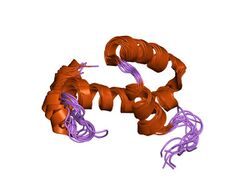Biology:Haemolysin expression modulating protein family
| HHA | |||||||||
|---|---|---|---|---|---|---|---|---|---|
 solution structure of hemolysin expression modulating protein hha from escherichia coli. ontario centre for structural proteomics target ec0308_1_72; northeast structural genomics target et88 | |||||||||
| Identifiers | |||||||||
| Symbol | HHA | ||||||||
| Pfam | PF05321 | ||||||||
| InterPro | IPR007985 | ||||||||
| SCOP2 | 1ir6 / SCOPe / SUPFAM | ||||||||
| |||||||||
In molecular biology, the haemolysin expression modulating protein family is a family of proteins. This family consists of haemolysin expression modulating protein (Hha) from Escherichia coli and its enterobacterial homologues, such as YmoA from Yersinia enterocolitica, and RmoA encoded on the R100 plasmid. These proteins act as modulators of bacterial gene expression. Members of this family act in conjunction with members of the H-NS family, participating in the thermoregulation of different virulence factors and in plasmid transfer.[1] Hha, along with the chromatin-associated protein H-NS, is involved in the regulation of expression of the toxin alpha-haemolysin in response to osmolarity and temperature.[2] YmoA modulates the expression of various virulence factors, such as Yop proteins and YadA adhesin, in response to temperature. RmoA is a plasmid R100 modulator involved in plasmid transfer.[3] The HHA family of proteins display striking similarity to the oligomerisation domain of the H-NS proteins.
References
- ↑ "Role of the Hha/YmoA family of proteins in the thermoregulation of the expression of virulence factors". Int. J. Med. Microbiol. 291 (6–7): 425–32. February 2002. doi:10.1078/1438-4221-00149. PMID 11890540.
- ↑ "Evidence for direct protein-protein interaction between members of the enterobacterial Hha/YmoA and H-NS families of proteins". J. Bacteriol. 184 (3): 629–35. February 2002. doi:10.1128/jb.184.3.629-635.2002. PMID 11790731.
- ↑ "Sequence, identification and effect on conjugation of the rmoA gene of plasmid R100-1". FEMS Microbiol. Lett. 169 (1): 59–66. December 1998. doi:10.1111/j.1574-6968.1998.tb13299.x. PMID 9851035.
 |

